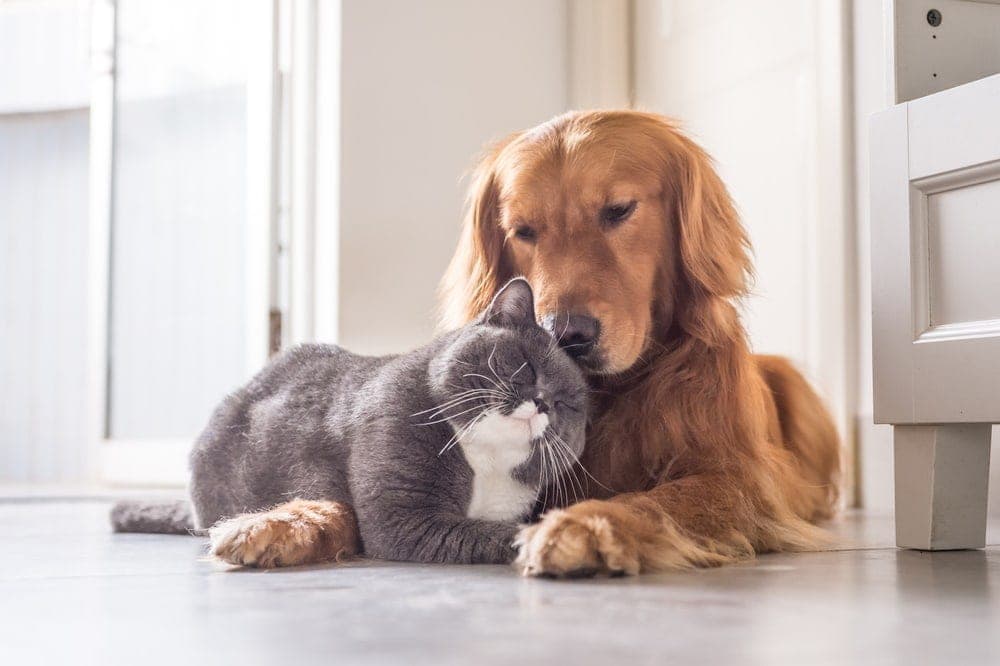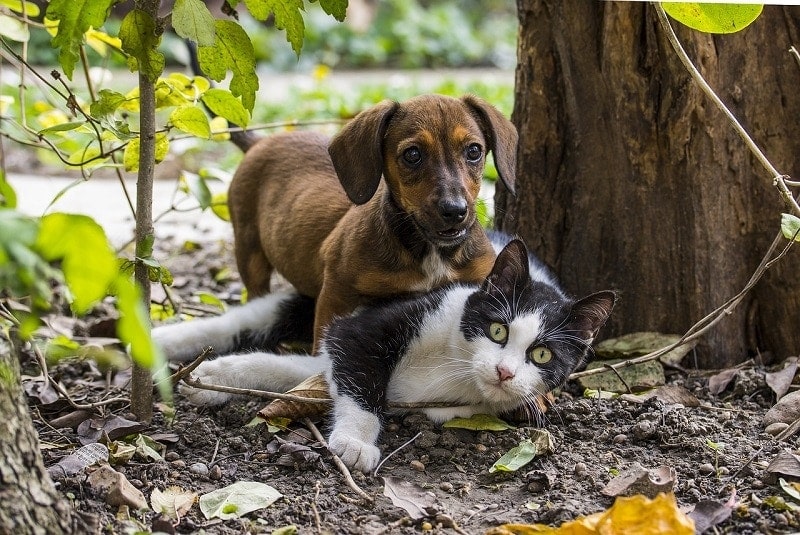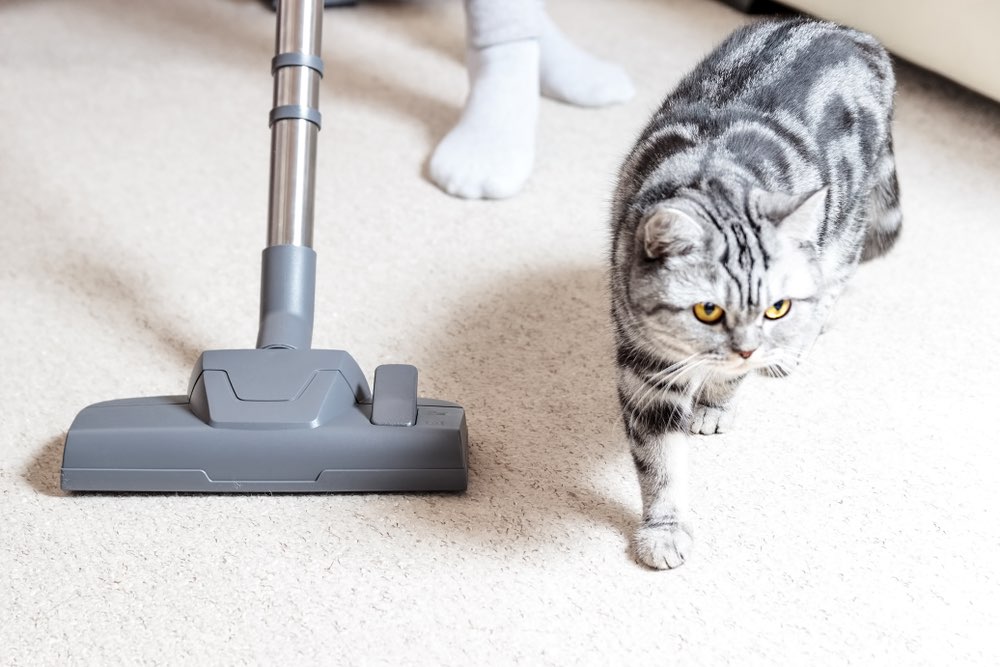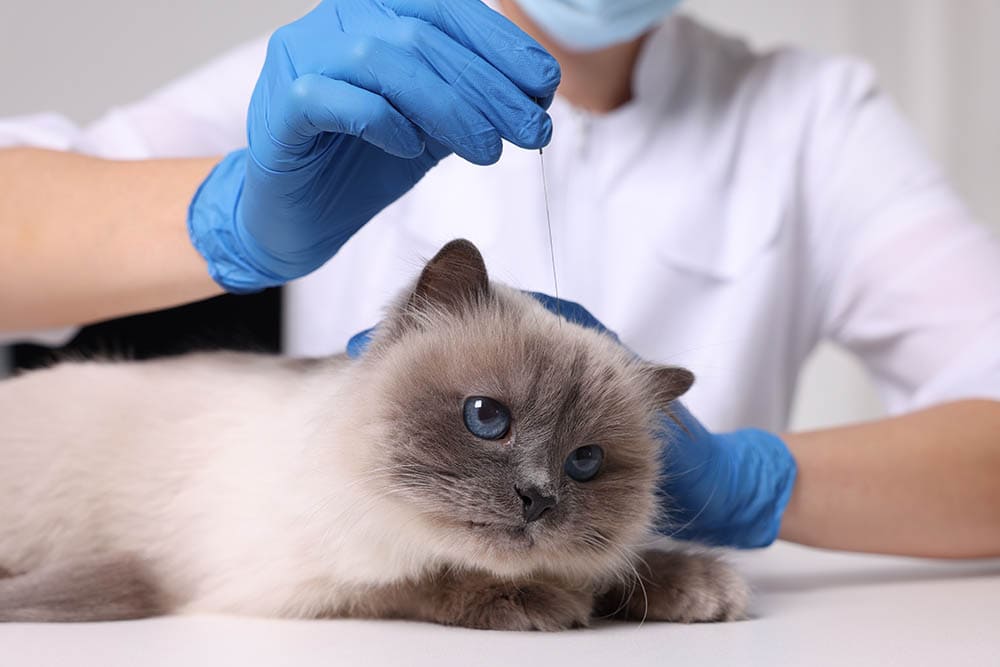Can Cats Be Allergic to Dogs? Science-Based Facts & FAQ

Updated on

Like humans, cats can be allergic to a variety of pollutants, such as pollen, fleas, and surprisingly, other pets. Can cats be allergic to dogs? Despite being rare, the answer is yes. However, while cats are rarely allergic to dogs themselves, as in their dander, they are more commonly allergic to something a dog is carrying in its coat, such as fleas or pollen1.
Read more about dog allergies in cats and see what options you have to treat your cat.
Dog Allergies in Cats
Dog allergies in cats can be caused by a variety of triggers. In many cases, cats are allergic to something on the dog, such as pollen in its fur, rather than the dog itself. This is different from humans who can be allergic to pet dander or the fur from only certain types of animals.
Cats can be allergic to dogs from several causes, including fleas, food, or airborne allergens. Airborne allergies are the primary cause, especially in certain seasons when dogs catch pollen from grass or ragweed in their coat and bring it home to the cat. Determining the source of the allergy is the most important part of treating it effectively.

Allergy Symptoms in Cats
- Watery or irritated eyes
- Skin rashes
- Itchiness
- Swelling or inflammation
- Coughing and sneezing
Pollen-based allergies usually cause skin irritation and itchiness. A normal amount of scratching is normal, but a cat with allergies will scratch constantly and generally look uncomfortable. You may also see signs of irritation in areas with less fur, such as the belly.

 Diagnosing Dog Allergies in Cats
Diagnosing Dog Allergies in Cats
If you suspect allergies in your cat, a veterinary visit is in order. Your veterinarian will perform an allergy prick test, which is done by scratching the skin with a small needle coated in a common allergen. These tests typically include all the common allergens, such as dog dander, pollen, dust mites, and fleas.
Once the test is complete, you’ll take your cat home and return to the veterinarian in a few days to have the scratch points examined. Your veterinarian will look for signs of significant irritation and redness to determine which allergens trigger an immune reaction in your cat.
As expected, some cats really don’t enjoy prick tests. Another option is a blood test for allergies. This test is less reliable, but it may help you and your veterinarian find the root cause of the allergy. Ask your vet which is best for your cat’s particular situation.
Treating Dog Allergies in Cats
Fortunately, you have several options to treat allergies in your cat. If the symptoms are already severe, your veterinarian may recommend cortisol or another topical cream that relieves the symptoms and gives your cat relief. Another option, though many cats won’t enjoy it, is a spray with soothing anti-itch ingredients like oats.
Cats are suitable for immunotherapy, which is a type of allergy vaccine. This treatment involves exposing the cat’s immune system to the allergen over time, giving it a chance to rebound and build a tolerance to the trigger.
Your veterinarian may also treat secondary infections caused by the allergies, such as skin infections from yeast or bacteria. This can occur when a cat is constantly licking or scratching to the point of breaking the skin, leading to more itching, then more licking and scratching in a vicious circle. In severe cases, cats may develop scales, pustules, or crusty areas.
Treatment for allergies in cats is two-fold: treating the allergy symptoms and reducing the triggers.
- Vacuuming your house regularly, especially surfaces that may hold dander or pollutants like carpets, furniture, and curtains.
- Keep dog blankets and beds clean to avoid introducing more dander into the air.
- Bathe both your dog and cat as regularly as possible to wash away the allergens. This is especially important if your dog is exposed to pollen and other seasonal triggers during the season, just make sure not to overdo it or you’ll strip both pets’ coats of natural oils.
- Wipe down hard floors and surfaces to prevent dust and dander buildup.
- Keep the dog and cat separated. They don’t need to be in separate rooms entirely, but you use gates to limit their interaction. You can also move the dog’s toys and bed into one area and the cat’s perches and trees into another to give them some distance.
- Speak to your veterinarian about adding omega fatty acids to both your dog’s and cat’s diets to support skin and coat health.

Final Thoughts
While dog allergies in cats are often caused by an environmental pollutant, and not the dog itself, any type of allergy trigger can make your sensitive cat miserable. Treating allergies among your pets requires the guidance of a qualified veterinarian for testing and medication and your diligence in keeping your home as allergy-free as possible.
Featured Image Credit: Chendongshan, Shutterstock

 Diagnosing Dog Allergies in Cats
Diagnosing Dog Allergies in Cats










